A week ago, Tropical Storm Helene knocked out my power, cell service, internet, and water for four days. I spent those four days in blissful ignorance, reading books, cooking stews over a campfire, boiling creek water, and hanging out with family and neighbors. Meanwhile, my out-of-town family were all worried sick. They were seeing the dire news reports that I didn’t have access to. So it was only days after the storm, when my power and internet access were restored, that I was able to see how much worse many of my neighbors had it.
Now that I’ve had a chance to get the lay of the land, here’s my prognosis: this is serious, y’all. Helene is a hellion.
Surveying the Destruction
In my town of Marshall, NC, there was record flooding. Volunteer crews have been hard at work cleaning up the tiny downtown area all week. For this work, it is necessary to don full hazmat gear because the flood waters contained toxic sludge from destroyed industrial plants upriver. The toxic sludge has dried and become toxic dust, which is eating through the volunteers’ boots.
CORRECTION ISSUED 10/9: The toxic sludge/dust was not eating through people’s boots as originally reported in one of my local social media groups, but just discoloring them. There may have been some minor chemical burns sustained, but I haven’t been able to confirm. The chemical of concern was researched and determined to be relatively safe to work around when dry. Full hazmat gear was suggested at the time I wrote this post, but later it was decided that normal PPE (gloves, masks, face shields) would do as a precaution against both the chemicals released by the upriver plastics plant and other household chemicals, bacteria, and environmental toxins floating down the river from the flood.
Below are photos from nearby Chimney Rock and Lake Lure, NC, two high-elevation sister towns mainly focused on tourism. The villages, hillside houses, basically the whole community were washed into the lake.
Western North Carolina’s largest city, Asheville, was hit extremely hard. The sheer volume of flood waters on the banks of the French Broad and Swannanoa Rivers was absolutely unimaginable before this past week. The destruction is widespread, severe, and positively overwhelming.
Most of Asheville is still without power and water. The power is expected to be restored by tomorrow to many neighborhoods (we’ll see), but the municipal water and sewage system has been so severely damaged that no one is making any promises or declaring timelines for getting it fixed.
Many surrounding towns are in even worse shape. There are still residents of nearby towns and more remote areas who are stranded without food, water, or communications due to impassable roads. More people are being reached every day. From my little holler, I hear helicopters flying overhead a dozen times a day. They are scanning the ground for SOS messages and signs of survivors; airdropping supplies to tiny mountain communities cut off from the world.
The official death counts of 150 (for the entire region affected by the storm) and 64 (confirmed in North Carolina alone) is likely lower than the reality.
The Survivor’s Day-to-Day
Power and internet service has been restored in some areas, including my neighborhood. Power means clean water for people who are on a well. But for those whose water comes from municipal systems, there is still a boil warning.
We do not have reliable cell reception, if we have any at all. Although some people have had power and internet restored to their homes, many of us are unable to make or receive phone calls.
Stores are reopening in limited areas that have had power restored, but they are almost universally cash-only. Many ATMs are either offline or out of cash, and many banks are still closed. In my town, a local credit union branch has mounted a valiant effort to serve its members in this time of great uncertainty. Even though they are without internet, they have devised a system whereby a couple of tellers whose personal cell phones are operational use their phones to call a Raleigh branch, where dedicated tellers enter account numbers into the computer system to enable cash transactions at the local branch. Of course, this means members have to wait upwards of 45 minutes to withdraw funds. Still, we’re so thankful.
There are long lines for gas, as well…if you can find it. Many of the open grocery stores are limiting the number of people who can enter at once, so there are lines to buy groceries, too, and the stock is dwindling.
The biggest food bank in the region, despite a strong effort to save its store of food, had its warehouse flooded. That definitely impacts the availability of relief food. But other local charities, certain corporate supermarket chains, and spontaneously formed groups of neighbors are rising to the challenge.
Immediately in the days after the storm, I began to see inspiring stories of mountain people helping each other. Of folks on horses and mules, carrying supplies to the more remote communities that have been cut off by this storm. Of restaurants and food trucks hooking up generators and serving free food to the community. Of friends running dangerous supply missions to Charlotte and back. Of neighbors building foot bridges across ravines so people can get out to buy groceries. Yes, it’s dire. But Appalachia has got this.
This is going to be a very long recovery. There are still upwards of 400 road closures in Western North Carolina alone. Fortunately, the two major highways that were severely damaged have been partially repaired so that we can get supplies in and evacuees out of the region.
I want to thank everyone who has prayed for my neighbors, everyone who has reached out with words of concern and encouragement, everyone who has offered financial help to our recovery efforts. The vast majority of commentary I’ve seen from people online has been full of love and support.
However, there has also been some victim blaming. A bit too early, if you ask me. I’ve seen some heartless (and ridiculous) comments about how Appalachians have no excuse to say we didn’t know the storm would be this bad, and that we should have been better prepared. I want to address this mentality briefly here.
Appalachians Underprepared?
First off, Appalachians in general are vastly more prepared for disaster than the average American. Most mountain people are rural, competent, resilient af, and fluent in the Old Ways. We still garden, can, hunt, preserve, raise livestock, and make our own herbal medicines. Practically every holler has at least two dudes who own a trackhoe or a bulldozer and know how to grade a driveway or divert a creek. Many of us drive old pickup trucks, heat our homes with wood we cut and split ourselves, do our own auto repairs. We can skin a buck, run a trout line, all that. A mountain boy can survive.
We get flash floods every year in Appalachia. I think most people here are prepared for normal flash flooding, if they live in flood zones. This wasn’t normal. It was more on the biblical scale. Also, it wasn’t just people in valleys and hollers that were affected. We’re talking about landslides that took the sides off mountains and brought houses and entire towns down with it. Destruction on a scale unprecedented in this area.
I’m not saying we’ve never seen a landslide. Yes, they happen from time to time, especially on roadways that are graded into the sides of mountains. But they don't typically happen everywhere, all at once, combined with record flooding of towns everywhere, all at once, and power grid destruction everywhere, all at once. I don't think people understand the scope here.
It would be impossible to be fully prepared for an event of this scale. It takes 100x the manpower to repair infrastructure that is destroyed everywhere, all at once than we can reasonably be expected to have. (Fortunately we have linemen, road crew, and other tradesmen arriving from out of town and out of state by the hundreds to assist the local crews.) It takes many times the resources to provide for people who, prepared or not, lost their homes, lost power, lost access to clean water.
I’m positive there are lessons to be learned here about how to be better prepared. That is true in any disaster situation. But to tell the Appalachian people that we should have known is a callousness beyond belief.
As a lowkey prepper, I have to reiterate this truth to other preppers all the time: being prepared does not guarantee you'll make it through whatever catastrophe you're envisioning with minimal loss. Because your envisioning cannot take into account every contingency that a disaster, natural or manmade, will throw at you. The community of Chimney Rock has existed for over 100 years, and it is simply no more. There was nothing that could have prepared those people for the literal wiping off the map of their town. The surrounding communities were prepared with the equipment and the willpower to make their way up there over roads that no longer exist to rescue the survivors. That's about all the preparation one could expect in that particular situation.
The truth is, many people were about as prepared as they could have been and those people (along with people who were less affected by property damage and loss of life) have been the boots on the ground, helping neighbors who either weren't as prepared or who, due solely to their geographic position, suffered the worst losses.
Mutual Aid, Not Government Aid, Most Effective
One thing I want to make clear to people watching this aftermath play out from afar: it is the local people, local businesses, local houses of worship, and local charities who are doing the majority of the relief work and making recovery happen at this stage, and I expect that to continue. This is not the same as other hurricane relief efforts that we have seen, in that we were never advised to evacuate. No one could have predicted it would be bad enough to necessitate evacuation. In a way, that’s sad because it means that many more people died than might have if we’d had better prediction of the storm’s severity. In another way, it’s good. Because we had local boots on the ground on Day 1.
There is a spontaneous order that emerges at the intersection of skillset and necessity, if we let it. For instance, the Asheville area is home to a vibrant music scene, and hosts many popular music festivals both in the city and in the surrounding rural areas each summer. One of the first alliances to get started on serious relief efforts were local festival crew, coordinating with local businesses to provide bottled water, prepared meals, wifi hotspots, baby supplies, and other needs to folks in Asheville. These “festy kids” are now branching out to deliver needed supplies to surrounding communities.
State and federal agencies and national NGOs are here by this point. But by the time they arrived the locals had already gotten started and still, a week in, I’m hearing reports of the government agencies still getting ready to get ready, or directing self-deployed volunteers to cease their efforts. Too many reports to dismiss. Most of the real efforts I am seeing are being efficiently organized and directed by local people.
Almost all the aircraft running search and rescue missions and air-dropping supplies are privately owned. Civilians are using their own 4WD vehicles and ATVs to deliver supplies to areas cut off due to impassable roads.
I am not reporting on any of this as a plea to send more government help or get the Red Cross and Salvation Army to do more. Please, if you want to help, donate to the local non-profits and churches or send funds to individuals you know who live in the affected areas. They know the terrain and how to navigate it. They know who needs help and what kind of help is needed. They are competent and capable. They don’t have international boards of directors to answer to, and they know where to put your donated funds for maximum impact. They aren’t burdened with unnavigable labyrinths of bureaucracy, nor do they have more pressing expenses to fund, like foreign wars.
I think that goes for any major disaster relief effort. I have seen so many stories of relief efforts being bungled by government agencies and huge NGOs in my lifetime, it’s kind of sickening. Recall, if you will, Hurricane Katrina as just one example of this phenomenon. But things have changed a lot since 2005. With peer-to-peer payment platforms, we now possess the technology to bypass the bureaucratic middle men, getting our donated funds right to the local organizations and individuals who know how to use it, immediately and effectively. Decentralized mutual aid, facilitated by local people and assisted by friends around the globe, is the future of disaster relief. And the future is now.
As of today, these are a couple of locally-based relief organizations that I can personally recommend:
I am working on a more comprehensive list of trusted local organizations that people can donate to. I will publish that list by end-of-day tomorrow.
UPDATE: Here is the better list of organizations to donate to. I will be adding more orgs as I learn of them.
Helene Relief: Where to Donate
Check out my first update on the Appalachian aftermath of Helene here.
Me and Mine
My family and I are safe. We are blessed. We were about as prepared as we could have been, in terms of food storage and the ability to survive without modern conveniences for a few days.
Although we were more fortunate than many of our neighbors in terms of property damage and access to needed supplies, this disaster has impacted my ability to earn income and pay the bills. If you feel so inspired, you can help me get through this by becoming a paid subscriber to this Substack.
I will be publishing updates on the aftermath at least twice a week going forward, for as long as necessary. In addition, my Prayer of the Week will reinstate this Sunday after a brief hiatus, and I am working on more content focused on spiritual and heart-centered responses to our present dystopia, both in Appalachia and around the world. All of my content will remain free to view for the time being. But for those who would like to support this work, I am setting the minimum paid subscription to $5 per month, which is the lowest Substack will allow. Any amount you would like to contribute in appreciation is welcome and gratefully accepted.

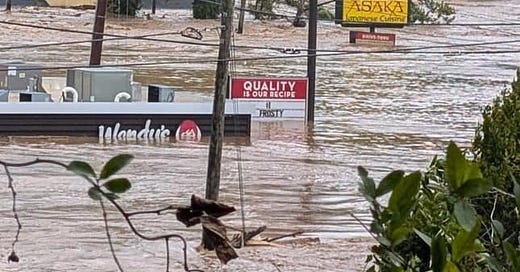



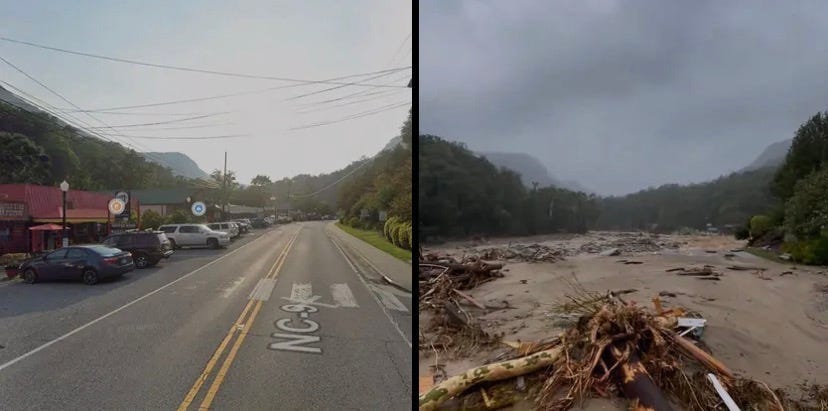
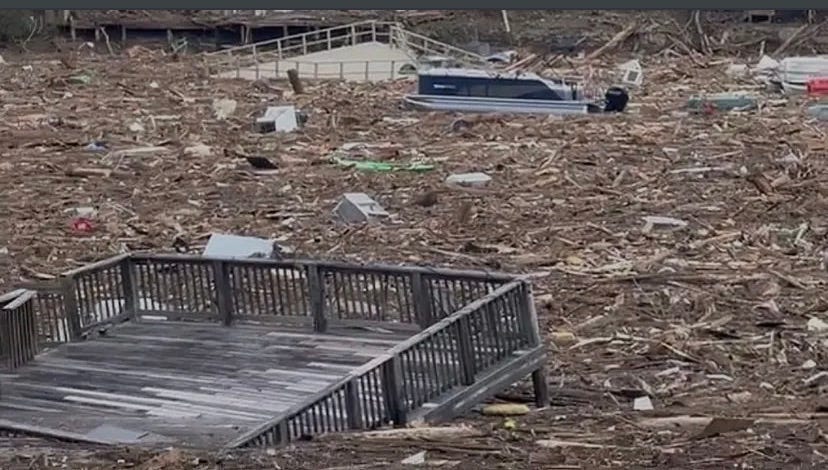
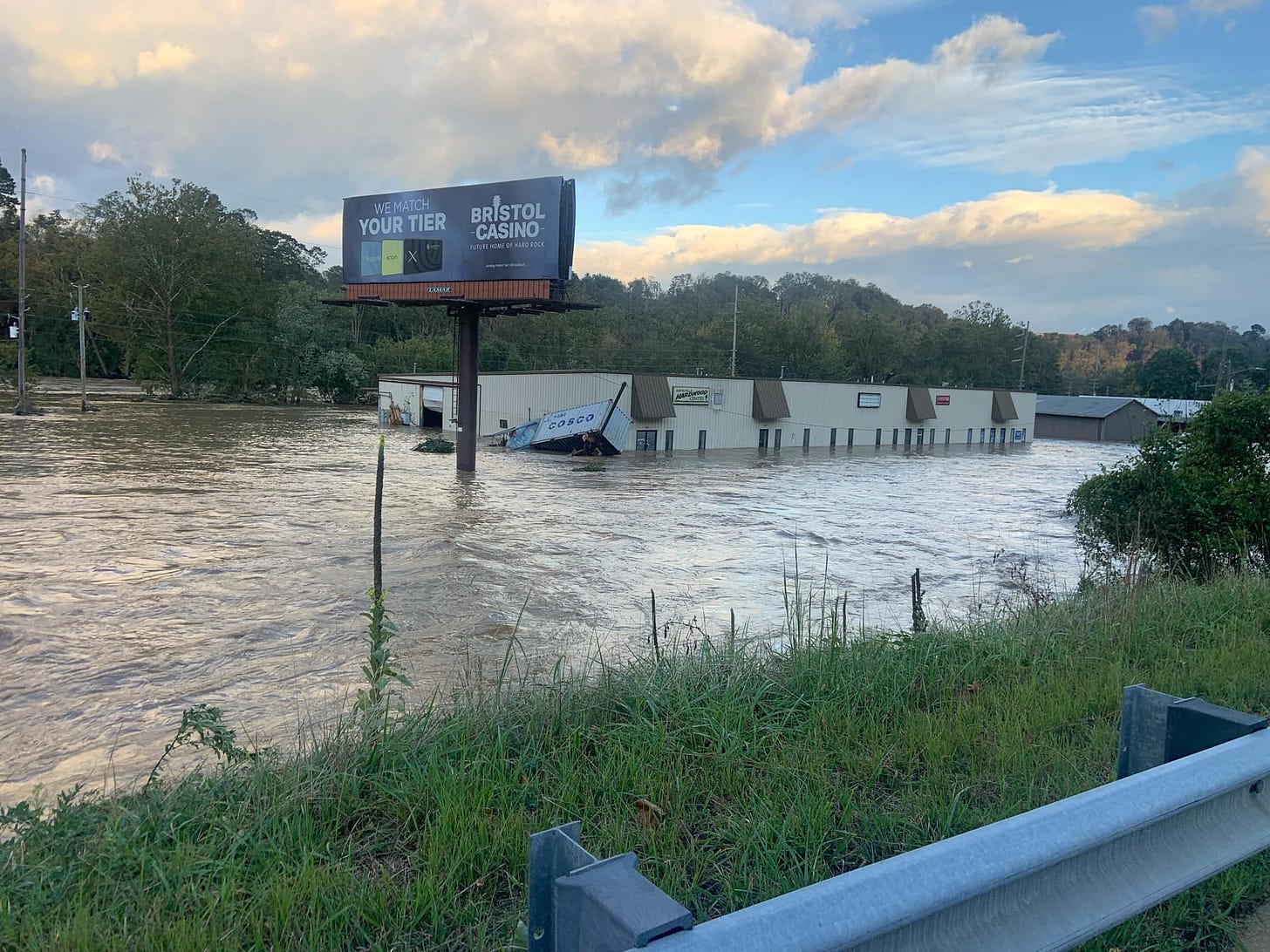
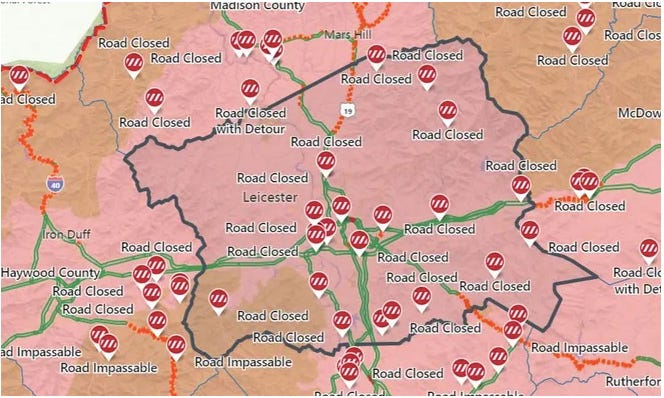



Thanks for this report, Starr. This kind of on-the-scene reporting is what's too often missing from the broadcast media. Praying for you and yours +
Thank you for this report and for listing worthy local non-profits to donate to. Embarrassingly, I'm more affected by this than I have any right to be as my husband and I were just there on vacation in August. We stayed at an Airbnb in Marshall, in fact. Spent a day at Chimney Rock, shopped & had lunch where there is now nothing but shards. We started visiting this part of the country in 2020 because it was one of the few that mostly ignored the Covid nonsense. Our hearts are with you and your beautiful corner of the world.